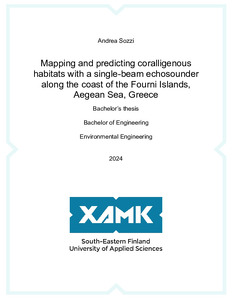Mapping and predicting coralligenous habitats with a single-beam echosounder along the coast of the Fourni Islands, Aegean Sea, Greece
Sozzi, Andrea (2024)
Sozzi, Andrea
2024
All rights reserved. This publication is copyrighted. You may download, display and print it for Your own personal use. Commercial use is prohibited.
Julkaisun pysyvä osoite on
https://urn.fi/URN:NBN:fi:amk-202404237448
https://urn.fi/URN:NBN:fi:amk-202404237448
Tiivistelmä
The aim of the study was to provide information about the potential distribution of coralligenous habitats by introducing a methodology to assess, classify, predict, and map the potential presence of such formations of the seabed from single-beam echosounder (Simrad EK 80). The data was collected during a two-day boat survey along the coastline of the Fourni Islands, Greece, on the 25th of September 2023 covering east, south and west of the area of interest, and on the 26th of September 2023, covering the northern part of the area.
Features of the bottom of the sea were first extrapolated from the acquired sonar data, by running a bottom classification module in Echoview 13 licensed software. Subsequently, from the derived selected features, a Random Forest (RF) classifier was developed in Python environment (and Scikit-learn library) to determine prediction of potential presence “Yes” class, and non-presence “No” class. The RF model was created and trained with the dataset of the first-day survey by reviewing topographic characteristics of coralligenous assemblages, such as depth and structure, together with the echograms from the echosounder data. Citizen science data, images, and videos from Remote Operated Vehicle (ROV) dives performed in the area of interest were also considered when developing the model, as complementary data. The RF classifier was then applied on the second-day survey dataset, and its performance tested. The accuracy, precision, recall, and F1 score of the model were 90, 73, 93, 81 percent, respectively. The predicted potential coralligenous presence segments were then mapped along the transect in GIS software for cartographical representation.
Ground truthing should be employed to ultimately confirm the predictions of the Random Forest classifier. However, considering the intrinsic challenges to explore these marine habitats, the developed methodology and the RF model provide the commissioner with more tools to define coralligenous formations in the area of research, in the effort to optimize conservation endeavors and protection activities of these hidden underwater gems.
Features of the bottom of the sea were first extrapolated from the acquired sonar data, by running a bottom classification module in Echoview 13 licensed software. Subsequently, from the derived selected features, a Random Forest (RF) classifier was developed in Python environment (and Scikit-learn library) to determine prediction of potential presence “Yes” class, and non-presence “No” class. The RF model was created and trained with the dataset of the first-day survey by reviewing topographic characteristics of coralligenous assemblages, such as depth and structure, together with the echograms from the echosounder data. Citizen science data, images, and videos from Remote Operated Vehicle (ROV) dives performed in the area of interest were also considered when developing the model, as complementary data. The RF classifier was then applied on the second-day survey dataset, and its performance tested. The accuracy, precision, recall, and F1 score of the model were 90, 73, 93, 81 percent, respectively. The predicted potential coralligenous presence segments were then mapped along the transect in GIS software for cartographical representation.
Ground truthing should be employed to ultimately confirm the predictions of the Random Forest classifier. However, considering the intrinsic challenges to explore these marine habitats, the developed methodology and the RF model provide the commissioner with more tools to define coralligenous formations in the area of research, in the effort to optimize conservation endeavors and protection activities of these hidden underwater gems.
